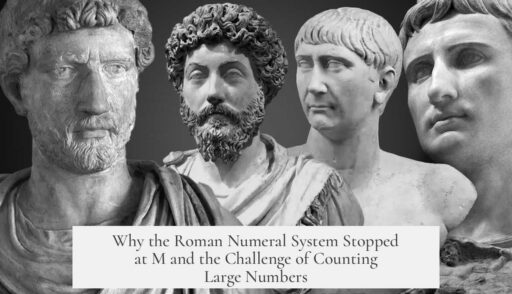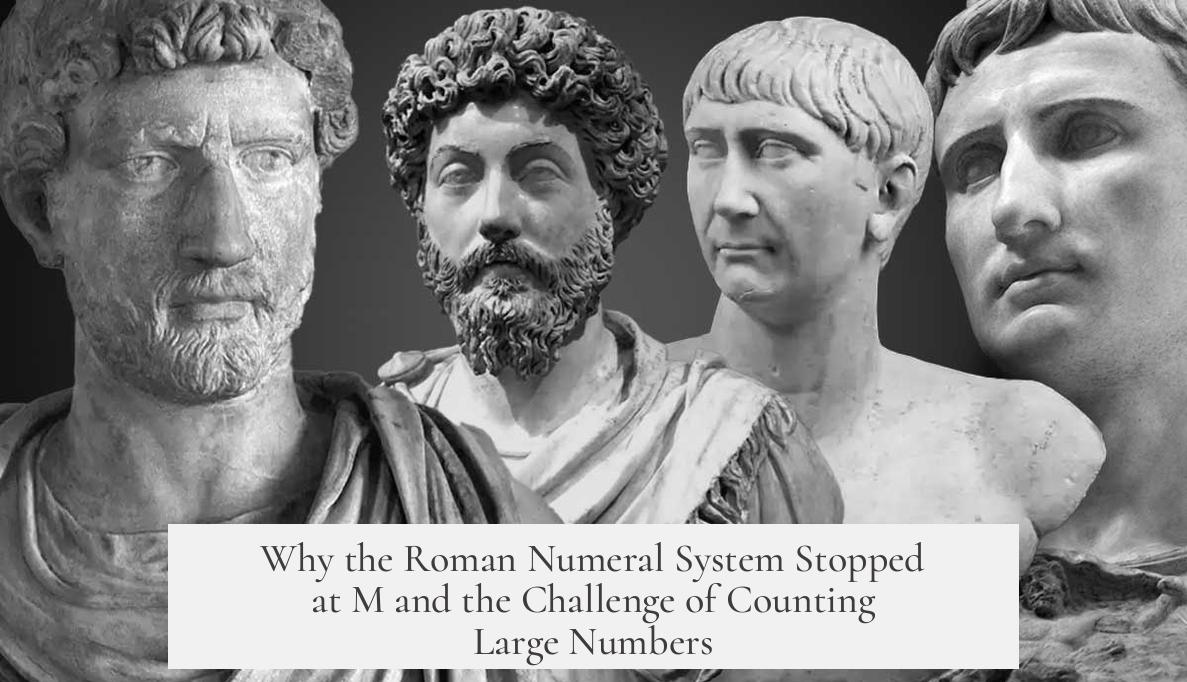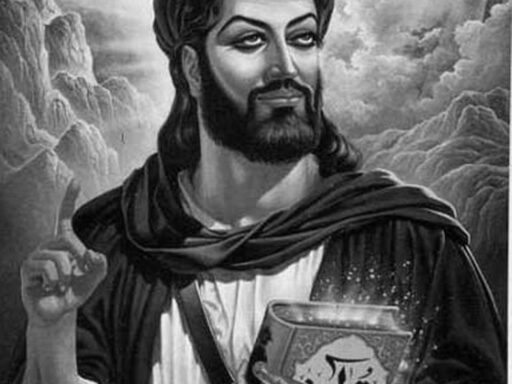The Roman numeral system traditionally uses the symbol M to represent 1,000 and does not extend simple symbols beyond this value. Higher numbers like 50,000 or 100,000 require additional notation systems beyond merely repeating M multiple times. Ancient and medieval users adopted methods such as the Vinculum and Apostrophus to represent large numbers efficiently.
Roman numerals consist of seven basic letters: I (1), V (5), X (10), L (50), C (100), D (500), and M (1,000). The system handles thousands by stacking Ms, for example, 3,000 is MMM. However, writing very large numbers by repeating M many times was impractical and irregular. Therefore, other conventions developed to express high values.
There is variation in the historical usage of Roman numerals. Romans often wrote numbers irregularly. For instance, IIII could replace IV for 4, and other subtractive notations were sometimes inconsistent. This demonstrated that the numeral system was flexible but lacked a strict rule for very large numbers.
To handle numbers exceeding 1,000 systematically, two primary methods appeared: the Vinculum method using overlines and the Apostrophus method using semicircular marks.
- Vinculum Method (Overlines): Placing a bar or overline above a numeral multiplies its value by 1,000. For example:
- An overlined I (I) equals M, or 1,000.
- An overlined V (V) equals 5,000.
- An overlined L (L) equals 50,000.
- An overlined C (C) equals 100,000.
- Multiple Ms can be barred as well. For example, an M with a bar represents 1,000,000 (a thousand thousands).
This notation provides a way to express large numbers compactly without writing excessive symbols. It also avoids ambiguity from repeating Ms excessively. In medieval times, the exact style of the overline varied.
- Apostrophus Method (Semi-circular marks): This less common method uses half-circles placed around letters to multiply values:
- I> (I followed by a right semicircle) equals D or 500.
- I>> equals 5,000.
- I>>> equals 50,000.
- <<I>> equals 10,000.
- <<<I>>> equals 100,000.
- Also, combinations like <I>> represented 1,500 by mixing values.
The Apostrophus method was more complex and less standardized but served as an alternative notation during some periods.
It is essential to realize that the Roman numeral system was designed for practical counting, inscriptions, and record keeping rather than for advanced arithmetic or scientific notation. As such, the basic symbols and conventional formations were adequate for most daily needs. High numbers beyond a few thousand appeared rarely, so extensions like Vinculum and Apostrophus were developed for special instances.
This explains why the system stops at M in its fundamental form. Simply adding more Ms became bulky and confusing. Instead, extending the meaning of symbols with bars or semicircles allowed people to represent very large numbers like 50,000 or 100,000 in a manageable way.
| Method | Symbol Example | Value Represented | Notes |
|---|---|---|---|
| Basic Roman Numerals (Simple) | MMM | 3,000 | Repeating M denotes thousands but limited in practicality |
| Vinculum (Overline) | L | 50,000 | Bar multiplies base numeral by 1,000 |
| Apostrophus | I>>> | 50,000 | Half circles modify value, less common method |
| Vinculum (Barred M) | M | 1,000,000 | Represents one million |
Both methods show that Roman numerals expanded beyond M by adding notation rather than inventing new base symbols. The use of overlines (Vinculum) became standard in medieval manuscripts and helps bridge the gap to very high numbers.
In modern usage, Roman numerals rarely exceed a few thousand. Large numbers are usually written in Arabic numerals due to ease and clarity. However, understanding how Romans handled large numbers provides insight into the system’s historical development and limitations.
- Roman numerals use M for 1,000 but do not extend basic symbols beyond it.
- Repeating Ms beyond a few thousands was irregular and cumbersome.
- Vinculum method uses bars over numerals to multiply by 1,000, e.g., L = 50,000.
- Apostrophus method adds half circles around symbols for high values.
- These methods enabled representation of large numbers like 50,000 or 100,000 efficiently.
- Such notations evolved to meet the needs of record keeping rather than standard numeric operations.
Why Did the Roman Numeral System Only Go Up to M for 1,000? The Mystery of Counting Huge Numbers in Ancient Rome
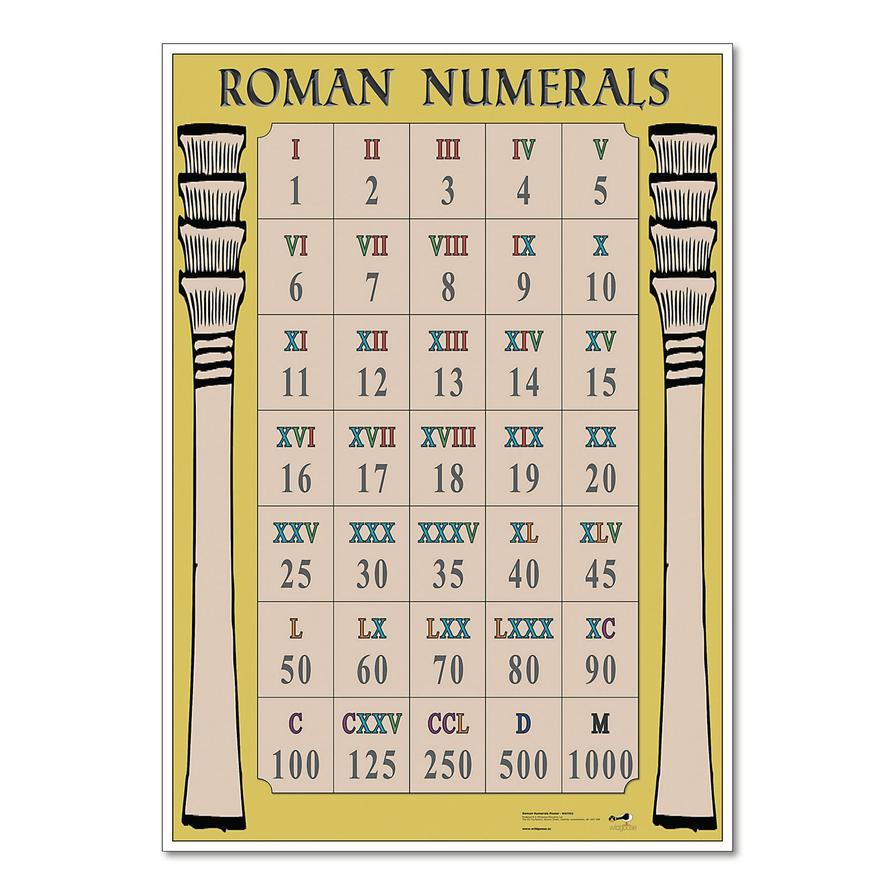
To answer the question right away: the Roman numeral system didn’t just stop at M (1,000); it actually had clever ways—like the Vinculum and Apostrophus methods—to represent really large numbers such as 50,000 or even 100,000. They didn’t pile up Ms endlessly. Instead, they invented nifty symbols and notations to manage big figures.
But let’s unpack this a bit because the Roman numeral system is much more fascinating—and irregular—than your middle school math teacher probably let on.
Modern vs. Historical Roman Numerals: The Tale of Two Systems
These days, you see Roman numerals like I, V, X, L, C, D, and M representing 1, 5, 10, 50, 100, 500, and 1,000. This system you know is actually a modernized version, which follows pretty consistent rules. When the US legal system sets numbers, for example, it treats Roman numerals like decimal digits: thousands, hundreds, tens, and units all neatly ordered. So, 99 becomes XC IX (90 + 9). But here’s a twist: the “compact form” sometimes swaps the two-part layout for a simpler subtraction rule, making 99 = IC, which feels a bit like cheating at math class!
Back in the day, the Romans were less rigid. Finding IIII for 4 instead of the neat IV was common. Heck, some inscriptions feature even stranger forms like IIIC for 97 or IIX for 8. It was a bit of a numeric Wild West—they tried to express numbers without rigid rules. Multiple notations for the same number weren’t unusual, varying by region or even temple.
So Why Is M the Largest Standard Symbol?
Good question. The base symbols stopped at M because 1,000 was already a large count for everyday Roman transactions. But what if an emperor’s army had 50,000 soldiers? Writing 50,000 Ms wouldn’t just be a pain—it would be downright impossible to read.
This is where Roman ingenuity saved the day.
Vinculum: Drawing a Line to Multiply
The Vinculum system is a surprisingly simple idea: put a horizontal line over a number, and you multiply it by 1,000. So:
- An overlined I = 1,000 (which is M)
- An overlined IV = 4,000
- An overlined L = 50,000
- An overlined C = 100,000
This notation made carving giant numbers into stone or writing in manuscripts a lot more manageable. And yes, in medieval times, it wasn’t always a neat line—it could be a pair of dots or another mark, but the idea stayed the same.
Want one million? Just put a bar over an M. Suddenly, your single character means a thousand thousands. Pretty cool, right?
Apostrophus: The Shape-Shifting Numbers
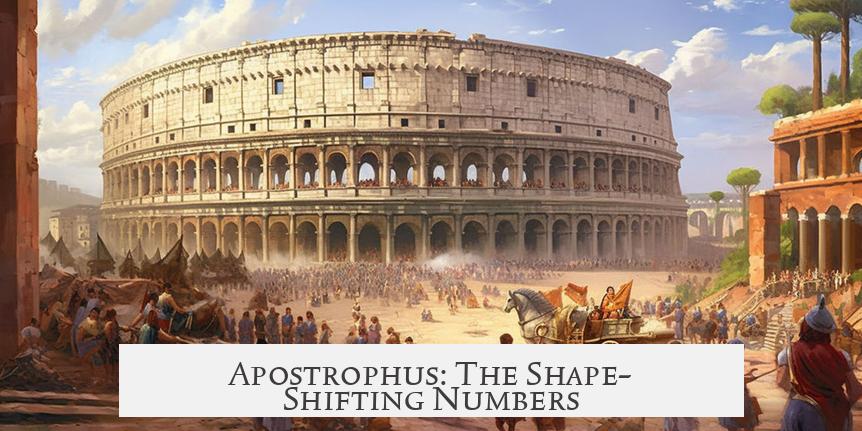
If the Vinculum was the “draw a line to zoom up numbers” system, the Apostrophus method was like Roman hieroglyphics for big numbers. It’s trickier to explain without visuals, but imagine using symbols made from half-circles around the letter I.
- I> equals 500
- I>> equals 5,000
- I>>> equals 50,000
Similarly, putting half-circles before and after I looks like <I>, which equals 1,000. Increase the number of these “brackets” and you reach 10,000 (<<I>>), 100,000 (<<<I>>>), and so on.
Rome’s accountants and scribes had these secret handshake symbols to count big numbers without writing endless repetitions. It’s a bit like the Roman equivalent of an emoji system for numbers!
Why Such Complexity? Practical Reasons, Not Vanity
The Romans used numbers mostly for records, trade, military, and official documents. Large amounts like 50,000 or 100,000 mattered for censuses, tax records, legion sizes, or grain inventories.
Writing a thousand Ms would not only eat up half the scroll but could also cause confusion. Using shortcuts like bars or apostrophi preserved space and made numbers easier to read and write. Plus, the legal and practical need for super-large numbers was less frequent in daily life.
So, What About Counting Beyond 100,000?
Believe it or not, with the Vinculum method, the Romans could theoretically scale up as high as they wanted by adding bars and bars over bars. That’s like having a number pyramid with multiple levels—each level multiplying the number below by 1,000. While rare, some medieval manuscripts used these extensions to record astronomical or financial data.
Still, adopting infinite complexity probably wasn’t needed. The Romans favored practicality over mathematician’s dreams.
Some Fun Takeaways and Tips for Using Roman Numerals Today
- Don’t fret if you see weird numbers like IIII on clocks. That was historically normal.
- Next time you see an overline on Roman numerals, think of it as a multiplier—1,000 times the normal value.
- If you want to be fancy and count in tens of thousands with Roman numerals, remember the Apostrophus: fewer letters, happy scribes.
What Does This Mean for You?
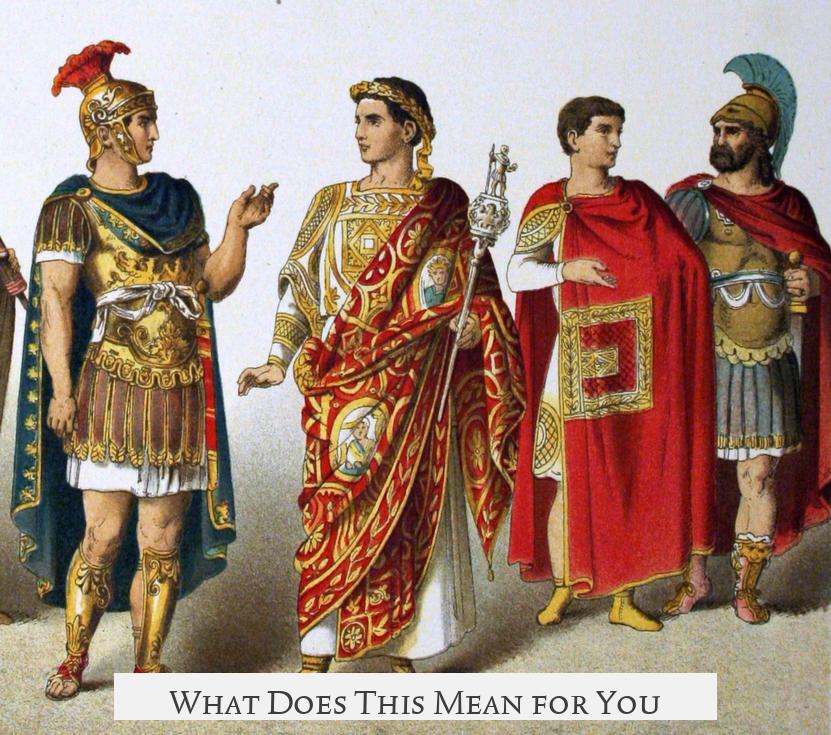
If someone asks you why Roman numerals stop at M for 1,000, you can smile and say: “Well, they didn’t really stop—they just got creative with lines and half-circles to count giant numbers.”
Roman numerals aren’t just ancient relics; they reveal how people once thought about numbers, space, and writing. They remind us that even without calculators, humans invented smart ways to handle complexity. So next time you see a Roman numeral on a building or a fancy event (like Super Bowl LIII, which is 53), you appreciate a system that was both practical and surprisingly flexible beyond what meets the eye.
Leaving You with a Thought…
In a world of digital displays and calculators, could revisiting old counting systems like Roman numerals inspire new ways to visualize large data? The Romans mastered efficiency with limited symbols—a lesson maybe worth remembering when tackling big numbers today.
